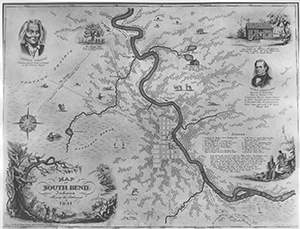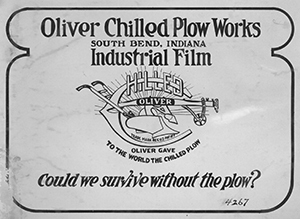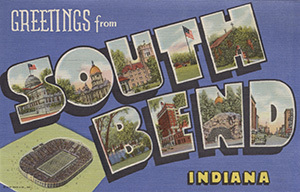History

Map of South Bend
South Bend has a rich and varied architectural history. The earliest buildings in what was to become South Bend were the log trading posts and cabins of the fur traders Pierre Navarre of the American Fur Company and Alexis Coquillard of John Jacob Astor's American Fur Company, located along the St. Joseph River. As their small trading village prospered, vernacular wood frame structures were built to accommodate homes, schools, and stores. One of the areas earliest surviving buildings is a cabin built by Pierre Navarre in the 1820s. This cabin can be visited today north of downtown South Bend in Leeper Park. Alexis Coquillard built a trading post in 1823 and eventually a store at the intersection of what is today Michigan Street and LaSalle Avenue beginning the development of downtown South Bend.
The population of South Bend grew quickly in the 1830’s and other stores were built in what is now the downtown area. By 1842, Coquillard had dug the East Race of the St. Joseph River, called the Lowell Race at the time, part of a project to bring more hydraulic power to the town, ensuring its development. The name Lowell came from the original name of the small town across the river from South Bend, which was quickly annexed into the city by 1866, becoming what is now known as the East Bank Village neighborhood.

Studebakers Foundry Employees
In 1852, Clement and Henry Studebaker arrived in South Bend and opened a blacksmith shop located at the intersection of Michigan Street and Jefferson Boulevard. Five years later they began building carriages and wagons, and in the years of Westward Expansion their business was wildly successful. Their company transformed again in 1902 when they began to build automobiles. The Studebaker plant in South Bend continued manufacturing cars until the automotive decline in 1963. The Studebakers' success and prosperity led to the sponsorship of several building programs in South Bend and the surrounding areas for commercial, civic, religious, and residential purposes. The Studebaker Mansion, now known as the Tippecanoe Restaurant, can be visited just west of the downtown area today. Other notable South Bend buildings include the JMS Buildinh on the corner of Main Street and West Washington Street, St. Paul’s Memorial United Methodist Church at 1001 West Colfax Avenue, and the ‘Studebaker Block’ located on the corner of Michigan and Jefferson (now demolished).

Oliver Chilled Plow Works Advertisement

Singer Sewing Machines

Birdsell Manufacturing Company
Another business that proved heavily influential in the development of South Bend was the iron works company of James Oliver, the inventor of the “chilled” plow. The Olivers settled in the South Bend area in the 1830s and built an iron empire that started with investments in the St. Joseph Iron Company and culminated with the Oliver Plow Works. This incredibly successful family sponsored the building of South Bend’s Opera House and the luxurious Oliver Hotel. Unfortunately neither of these buildings survive today. In addition, the Oliver family funded the creation of the first City Hall, the Oliver Row Houses, and built Copshaholm, the home of JD Oliver, which is still located on West Washington Street near the Studebaker Mansion.
Several other businesses established themselves in South Bend, attracted by the hydraulic power available from the East and West races of the river, including the Birdsell and Singer Manufacturing companies. Neighborhoods clustered around the downtown area quickly sprung up to house the growing population. These neighborhoods are now considered to be South Bend’s Historic Districts.

Vibrant Downtown South Bend
By the early 1900s, the downtown had developed into a series of vibrant street scenes and a very prosperous economy, which continued well into the 1900s until the Great Depression and the economic downturn of the 1930s. The city struggled to maintain its vibrancy for the next several decades. As South Bend struggled to adjust to a post-Studebaker economy in the 1960s it began a twenty-year project of ‘urban renewal’, which saw the destruction of much of the historic character of the downtown area. Streets were turned from two-way to one-way to allow for traffic to move through the city and the lively downtown community disappeared.

Greetings from South Bend, Indiana
In 2015, as South Bend celebrates its 150th anniversary, the downtown area is once again becoming the vivacious community it historically once was. The historic preservation movement has worked to save remaining historical buildings and the city is working to re-direct traffic to two-way streets, promoting the downtown area as a destination rather than a drive-through. Several historical buildings are in the process of modern renovations that will once again move people back to the heart of the city.
Bibliography
Division of Historic Preservation Archaeology. City of South Bend Historic Sites and Structures: An interim report of the Indiana Historic Sites and Structures Inventory. South Bend, Indiana: Historic Preservation Commission South Bend and St. Joseph County and Historic Landmarks Foundation of Indiana, 2007.
Palmer, John. South Bend in Vintage Postcards (Postcard history series). Arcadia: Charleston, South Carolina, 2007.
_____. South Bend, Crossroads of Commerce. Charleston, S.C.: Arcadia, c.2003.
Stamper, John W. City of South Bend: Summary Report, Indiana Historic Sites and Structures Inventory. South Bend, Indiana: Historic Preservation Commission of South Bend & St. Joseph County, 1981.